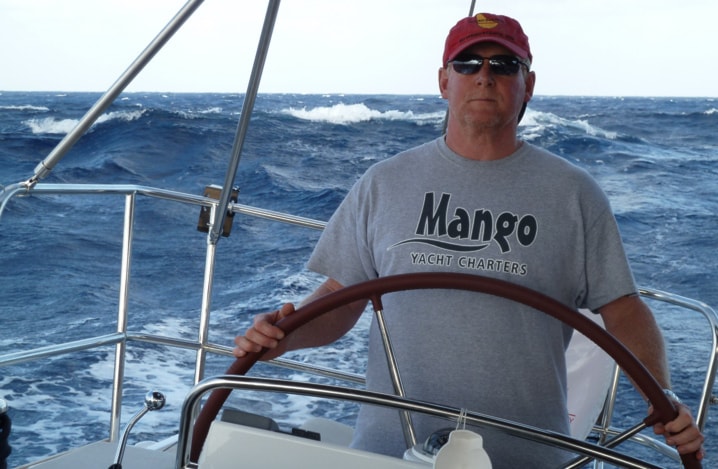He might be Central Albertan, but Marty Vellner is no landlubber.
The Red Deer resident fully discovered his sea legs during a bucket-list worthy cross-Atlantic sailing trip this fall.
Vellner set out on his epic, 24-day journey on Nov. 2 from the Canary Islands, off the northwest coast of Africa, and finished it on Nov. 26 in the British Virgin Islands in the Caribbean. That’s where he finally helped dock the 57-foot yacht he had purchased with four partners, including his childhood friend, hockey commentator Ron MacLean.
By that time the mono-hull craft, christened Nanuk (Inuit for great white bear), had sailed more than 3,000 miles across the ocean with a crew of six. On board was Vellner, Jim Miller, one of his investment partners from Ontario, and four men from the Georgian Bay area. (MacLean was busy with hockey season and could not make the trip).
The journey to bring the French-made boat, purchased in July, to a dock on this side of the Atlantic proved to be a life-changing adventure for Vellner.
The 53-year-old and his wife Tikki had sailed with friends, including MacLean, since the mid-1990s. But while Vellner had gone on shorter trips and raced yachts in Antigua, he had never attempted a trans-Atlantic crossing — it would require days and days of seeing nothing but wide blue sea and sky.
“The ocean is a big place,” said the president of Vellner Leisure Products Ltd., a local company that sells recreational vehicles.
The crew did not see land for 20 days — a longer than expected period because the east-west route had to be moved to a more southerly latitude to ensure a good wind behind the yacht, and to avoid a major storm system sweeping from Bermuda to England.
Vellner recalled the last boat they spotted was a lone tug towing a rig, shortly after leaving the Canary Islands. On Nov. 3, there was a pod of dolphins jumping and playing around the yacht. “After that, we never saw another ship or any other wildlife, other than some seabirds and flying fish, for 17 days.”
What the crew of the Nanuk did see was sparkling water, lots of sun (“There were amazing sunrises and sunsets,” said Vellner), and bountiful stars at night.
Vellner said two crew members would take a shift sailing the yacht for three hours, then take six hours off. That’s when he would read or play card games to alleviate boredom with the other sailors, who became his friends.
Late-night shifts were the worst, he recalled, because it was hard to get a good rest before or after. But while he was keeping a general eye on weather and ocean conditions (the yacht that sleeps 12 people has an auto-steering mechanism), Vellner passed the time by studying the constellations on a satellite-fuelled app on his iPod.
He recalled the strangeness of seeing familiar star patterns from a more southerly point in the Northern Hemisphere.
Not every day was smooth sailing. Occasionally the Nanuk would have to pass over 16-foot swells and waves — luckily none of the crew were prone to sea sickness, said Vellner.
Although the weather was generally warm and sunny, one day a sideways rain pelted the boat in the aftermath of a large storm system that passed further north.
Vellner said on-duty crew members would routinely tie themselves to the boat at night, just in case they went over. “No one would ever be able to find you out there in the dark.”
A potentially serious complication arose about midway in the trip when the generator on board broke down. But it was handily repaired by a crew member with some mechanical knowledge. (The crew had taken along spare parts.)
Apart from these ripples, the journey was calamity-free, said Vellner — bereft of sharks, pirates or hurricanes.
He was left exhilarated by the adventure, with a renewed sense of confidence from realizing he could adapt to very different conditions.
“It made me realize I can manage in a situation that was out of the ordinary. ... It was definitely a bucket-list kind of thing.”
Part of the success was due to good preparation. The crew brought along lots of water and supplies, said Vellner. “We were very well fed,” by two crew members who opted to do the cooking.
While a couple of manual sextons were brought on board, there was no need to use them because of the sail boat’s GPS system. Weather reports were also provided by various services. And, thanks to a satellite phone, Vellner was able to phone his wife on her birthday.
But despite all these technological advantages, the sailors knew that in a true disaster they were a long, long way from help. “A plane could probably reach us within a day to drop off supplies, but we were too far out for a helicopter.”
When Vellner finally reached land on St. Martin Island in the northeastern Caribbean, he did the sailor’s sway — that is his body was so used to the rocking motion of the yacht that he bumped into things.
The Central Albertan is already anticipating more sea adventures, but he’s not sure if he would repeat the same long trip — unless it starts from the Caribbean, where the Nanuk is now available for charters, and finishes in North Africa or Europe.
“At least you’d see things from a different perspective.”
lmichelin@www.reddeeradvocate.com
